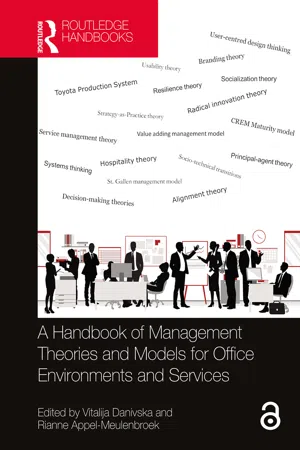
A Handbook of Management Theories and Models for Office Environments and Services
- 254 pages
- English
- ePUB (mobile friendly)
- Available on iOS & Android
A Handbook of Management Theories and Models for Office Environments and Services
About this book
Although workplace design and management are gaining more and more attention from modern organizations, workplace research is still very fragmented and spread across multiple disciplines in academia. There are several books on the market related to workplaces, facility management (FM), and corporate real estate management (CREM) disciplines, but few open up a theoretical and practical discussion across multiple theories from different disciplines. Therefore, workplace researchers are not aware of all the angles from which workplace management and effects of workplace design on employees has been or could be studied. A lot of knowledge is lost between disciplines, and sadly, many insights do not reach workplace managers in practice. Therefore, this new book series is started by associate professor Rianne Appel-Meulenbroek (Eindhoven University of Technology, the Netherlands) and postdoc researcher Vitalija Danivska (Aalto University, Finland) as editors, published by Routledge. It is titled 'Transdisciplinary Workplace Research and Management' because it bundles important research insights from different disciplinary fields and shows its relevance for both academic workplace research and workplace management in practice. The books will address the complexity of the transdisciplinary angle necessary to solve ongoing workplace-related issues in practice, such as knowledge worker productivity, office use, and more strategic management. In addition, the editors work towards further collaboration and integration of the necessary disciplines for further development of the workplace field in research and in practice. This book series is relevant for workplace experts both in academia and industry.
This second book in the series focuses on the role of workplace management in the organization and the tasks that workplace management needs to consider. The 18 theories that are presented in this book and applied to workplace research discuss management aspects from the organization's perspective or dive deeper into issues related to people and/or building management. They all emphasize that workplace management is a complex matter that requires more strategic attention in order to add value for various stakeholders. The final chapter of the book describes a first step towards integrating the presented theories into an interdisciplinary framework for developing a grand workplace management theory.
Frequently asked questions
- Essential is ideal for learners and professionals who enjoy exploring a wide range of subjects. Access the Essential Library with 800,000+ trusted titles and best-sellers across business, personal growth, and the humanities. Includes unlimited reading time and Standard Read Aloud voice.
- Complete: Perfect for advanced learners and researchers needing full, unrestricted access. Unlock 1.4M+ books across hundreds of subjects, including academic and specialized titles. The Complete Plan also includes advanced features like Premium Read Aloud and Research Assistant.
Please note we cannot support devices running on iOS 13 and Android 7 or earlier. Learn more about using the app.
Information
1
Collecting theories to obtain an interdisciplinary understanding of workplace management
1 Introduction
1.1 A complex wicked problem
- 1 the nature of the problem is viewed differently depending on the perspectives and biases of those with a stake in the problem,
- 2 multiple stakeholders are involved which disagree about the problem and the optimal solution,
- 3 it is unclear when the problem is actually solved,
- 4 what works in one context does not necessarily work in another, similar context.
Table of contents
- Cover
- Half Title
- Series
- Title
- Copyright
- Contents
- Preface
- List of contributors
- 1 Collecting theories to obtain an interdisciplinary understanding of workplace management
- 2 Corporate real estate management maturity model: Joroff et al. one step ahead
- 3 Systems-thinking theory: decision-making for sustainable workplace transformations
- 4 St. Gallen Management Model: systemic-constructionist approach to workspace organisations and management
- 5 Socio-technical transitions theory: a multi-level and change-oriented perspective on organisational space
- 6 Disaster Resilience of Place (DROP) model: a Resilience Assessment and Improvement Framework (RAIF) for facilities managers
- 7 Strategy-as-Practice: the social effects of workplace design and their impact on unplanned strategic activity
- 8 Decision-making theory: how a multiple perspective approach can generate workplace strategies
- 9 Alignment theory: for CRE and workplace
- 10 Principal-agent theory: perspectives and practices for effective workplace solutions
- 11 Branding theory contributions to corporate real estate management
- 12 Value Adding Management of buildings, workplaces, facilities and services
- 13 The Toyota Production System: applying the concept of waste in real estate management
- 14 Radical innovation theory: towards radical design of digital workplaces
- 15 Usability theory: adding a user-centric perspective to workplace management
- 16 User-centred design thinking: application of UCDT theories to workplace management
- 17 Hospitality theory: application of hospitality theory in the work environment
- 18 Service management – focus on customer experience
- 19 Organisational socialisation theory: integrating outsourced FM employees into organisations
- 20 Identifying the main constructs for an interdisciplinary workplace management framework
- Index